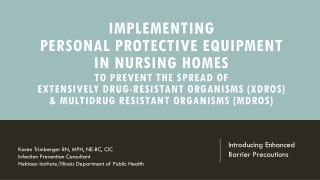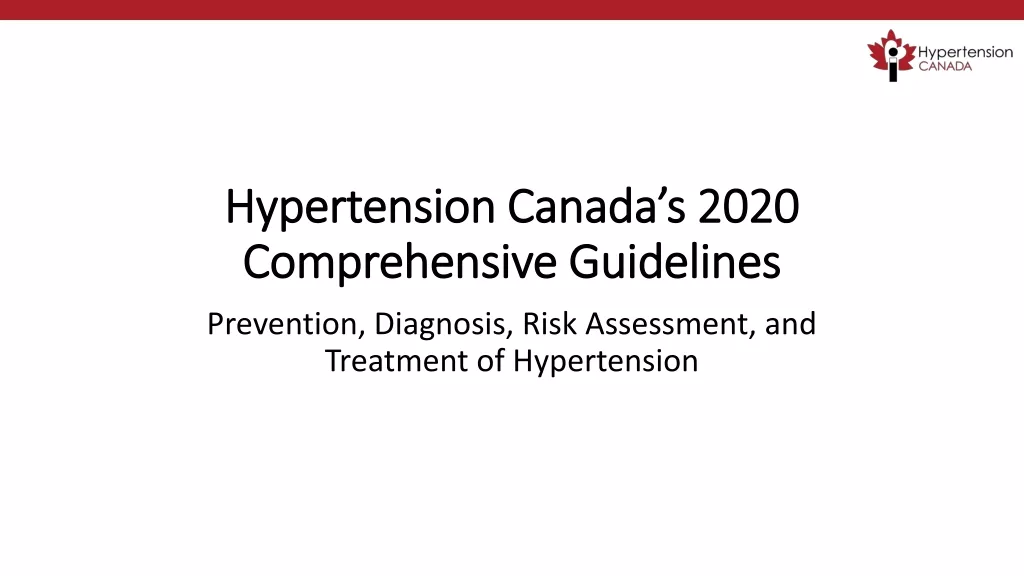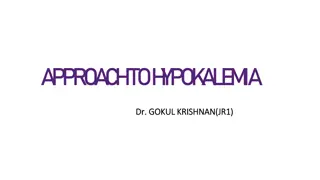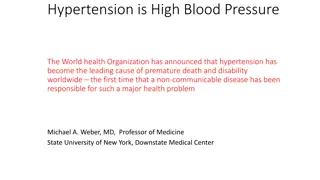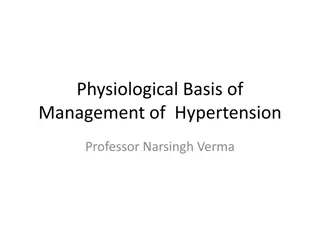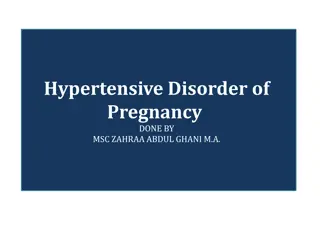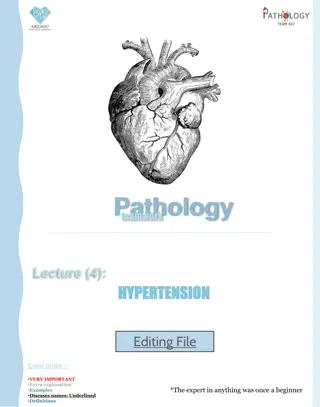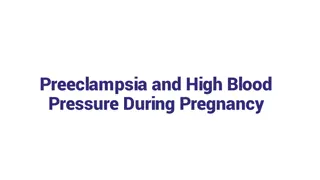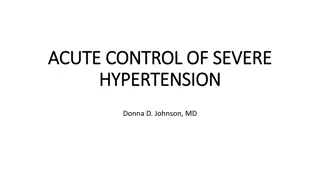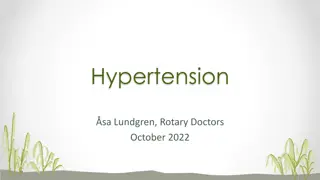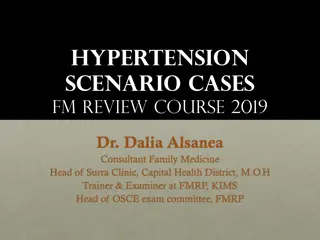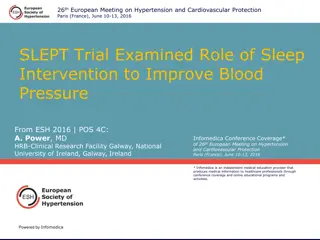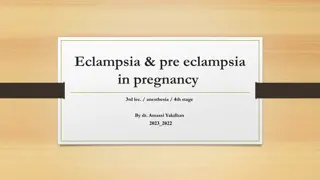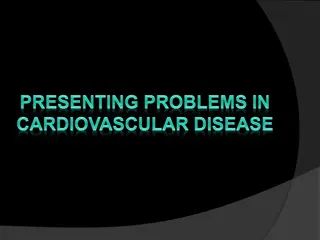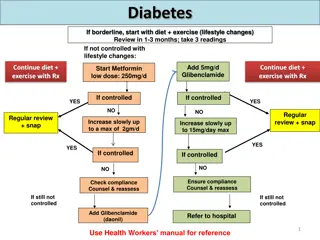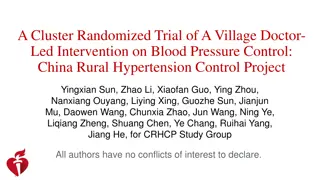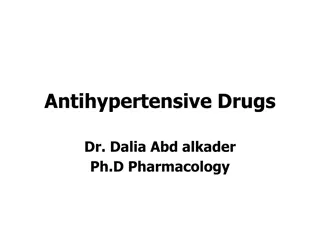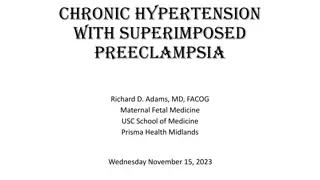Evaluation of Resistant Hypertension and Hypokalemia in a Young Female
A 38-year-old female with a history of resistant hypertension and hypokalemia was referred for evaluation. She had been on multiple antihypertensive medications but still had uncontrolled blood pressure and low potassium levels. After treatment with potassium supplementation and adjustment of medications, her symptoms improved, blood pressure normalized, and potassium levels returned to normal. Further investigations highlighted the importance of screening and managing primary aldosteronism in such cases.
Download Presentation

Please find below an Image/Link to download the presentation.
The content on the website is provided AS IS for your information and personal use only. It may not be sold, licensed, or shared on other websites without obtaining consent from the author. Download presentation by click this link. If you encounter any issues during the download, it is possible that the publisher has removed the file from their server.
E N D
Presentation Transcript
In The Name of God Primary Aldosteronism Salma Ahi, MD Fellow of Endocrinology Research Institute of Endocrine Sciences 2013 october
Clinical questions: why is PA important ? who should be screened for PA? How to perform screening and confirmatory tests? How to Lateralize the lesion without access to AVS? Outcome after treatment of PA
Background Why is PA important? This condition is important not only because of its prevalence, but also because PA patients have higher cardiovascular morbidity and mortality than age- and sex-matched patients with essential hypertension and the same degree of blood pressure elevation. Furthermore, specific treatments are available that ameliorate the impact of this condition on patient- important outcomes.
A 38 yrs old female referred to our center for evaluation of resistant HTN & hypokalemia She was hypertensive for the past 8 months under the care of a cardiologist Her medications included Losartan (50 mg/d), Aldactone (25 mg/d), Metoprolol (100 mg/d) and Hydrochlorothiazide (25 mg/d)
PMH: HTN Claims that his BP levels were almost always in the range of 150-160/90-100 mmHg Not smoker negtive history for use of herbal medications
BP=160/110 mmHg Eyes; Heart; Lungs: Unremarkable Muscle force: 3/5 +4/5 Serum potassium level was 3.1 meq/L Retrospective search in her lab data revealed a serum potassium level of 2.8 meq/L in about one months ago; she was unaware about this matter and had not been treated for hypokalemia at that time
Hospital Course: She was treated with oral and IV potassium Her antihypertensive drugs changed to Diltiazem (60 mg twice daily) and Prazosin (4.5 mg daily) Symptoms improved within 48 h BP was 140-155/80 mmHg and serum potassium level became normal (4 meq/L)
Lab Data: Hb=14.5 Cr=0.9 (GFR=87), Na=140, Mg=1.8, Ca=8.8, P=2.5 K: 2.9 3.1 4 PH=7.43, HCO3=29, Pco2=45 U/A: SG=1015; Pr (-); RBC=8-10 FBS=90, TG=171, Chol=168 LFT: Nl TFT: Nl (on LT4 Tx)
Other Paraclinical Data: EKG: NSR; Nl axis; No significant ST-T change Echocardiography: EF=60%; Mild LVH Mild MR & AI Urinary tract sonography & Doppler exam.: Normal sized kidneys Nl renal arteries
Case Detection: WHO? 1) JNC stage 2 and 3 HTN (8% and 13%) 2) Resistant HTN (17-23%) 3) HTN and spontaneous or diuretic-induced hypokalemia (?) 4) HTN and adrenal incidentaloma (1.1-10%) 5) HTN and a family history of early-onset HTN or CVA at a young age(<40ys)
Case Detection: HOW? ARR (plasma aldosterone-renin ratio) Medications with minimal effects on plasma aldosterone levels: I. Non-dihydropyridine Ca channel blockers (Verapamil) II. Vasodilators (Hydralazine) III. Alpha-adrenergic blockers (Prazosin, Doxazosin, Terazosin)
Measurement of the aldosterone-renin ratio: a suggested approach A. Preparation for aldosterone-renin ratio (ARR) measurement: B. 1.Attempt to correct hypokalemia, after measuring plasma potassium in blood collected slowly with a syringe and needle [preferably not a Vacutainer to minimize the risk of spuriously raising potassium], C. Avoiding fist clenching during collection, D. Waiting at least 5 seconds after tourniquet release to achieve insertion of needle, and E. Ensuring separation of plasma from cells within 30 minutes of collection.
2. Encourage patient to liberalize sodium intake. 3. Withdraw agents that markedly affect the ARR for at least 4 weeks: . Spironolactone, eplerenone, amiloride, and triamterene . Potassium-wasting diuretics . Products derived from liquorice root (e.g., confectionary licorice, chewing tobacco)
4. If the results of ARR off the above agents are not diagnostic, withdraw other medications that may affect the ARR for at least 2 weeks: Beta-adrenergic blockers, central alpha-2 agonists (e.g., clonidine, alpha- methyldopa), NSAID drugs Angiotensin-converting enzyme inhibitors, angiotensin receptor blockers renin inhibitors Dihydropyridine calcium channel antagonists
5. If necessary to maintain hypertension control, commence other antihypertensive medications that have lesser effects on the ARR (e.g., verapamil slow-release, hydralazine [with verapamil slow-release, to avoid reflex tachycardia],prazosin, doxazosin, terazosin;
6. Establish oral contraceptive (OC) and hormone replacement therapy (HRT) status, as estrogen- containing medications may lower direct renin concentration (DRC) and cause false positive ARR when DRC (rather than plasma renin activity) is measured. Do not withdraw OC unless confident of alternative effective contraception.
Conditions for collection of blood 1. Collect blood mid-morning, after the patient has been up (sitting, standing, or walking) for at least 2 hours and seated for 5-15 minutes. 2. Collect blood carefully, avoiding stasis and hemolysis. 3. Maintain sample at room temperature (and not on ice, as this will promote conversion of inactive to active renin).
Factors to take into account when interpreting results Age: in patients aged >65 years, renin can be lowered more than aldosterone by age alone, leading to a raised ARR Time of day, recent diet, posture, and length of time in that posture Medications Method of blood collection, including any difficulty doing so Level of potassium Level of creatinine (renal failure can lead to false positive ARR)
Factors that may lead to false-negative or false-positive ARR results:
Factors that may lead to false- negative or false-positive ARR results:
Our Case: Two months after change of his medications: PAC=40 ng/dL PRA<0.01 ng/mL/h ARR>4000
Case Confirmation: Four testing procedures: (No gold standard) 1. Oral sodium loading test 2. Saline infusion test (SIT) 3. Fludrocortisone suppression test 4. Captopril challenge test *Choice: cost, compliance, lab routine, local expertise
SIT: Lack powerful study designs for establishing the test accuracy Sensitivity: 83-88% Specificity: 75-100%
Our Case: SIT: Start End PAC (ng/dL) 30.2 41.7 PRA (ng/mL/h) 0.01 0.01 Cortisol (micg/dL) 20 8.7 Potassium (mg/dL) 4 3.3 PAC/Cortisol 1.51 4.8
Subtype Classification: Adrenal CT scan Adrenal venous sampling (AVS): If surgical treatment is practicable and desired by the patient To distinguish between unilateral and bilateral adrenal disease Ancillary tests
Adrenal CT Scan: APA: usually < 2 cm, hypodense nodule IHA: normal-appearing or unilateral or bilateral nodular changes Aldosterone-producing adrenal carcinomas: almost always > 4 cm and with suspicious imaging phenotype Sensitivity: 48-58%; Specificity: 90% Several Limitations especially in older patients (>40 yr), thus: AVS is essential to direct appropriate therapy
Our Case: Adrenal CT scan: A 10 mm mass with soft tissue density in lateral limb of left adrenal
Unsuccessful or unavailable AVS: 1) Repeat AVS 2) Treat with MR antagonist 3) Consider surgery based on the other studies: Adrenal CT Scan Posture Stimulation Test Morning Recumbent 18-OHB levels Not available Low accuracy
Posture Stimulation Test: The absence of the significant increase (<30%) of PAC at the upright posture supports the diagnosis of APA Test accuracy: 85% Fontes RG, Am J Hypertens 1991;4:786-91 Young WF, Endocrinol Metab Clin North Am 1988;17:367-95 The fall in PAC during 4 h erect posture has PPV of 100% for diagnosis of unilateral lesion Espiner EA, J Clin Endocrinol Metab 2003;88:3637-44
18-Hydroxycorticosterone levels Patients with APA generally have recumbent plasma 18-OHB levels greater than 100ng/dL at 8:00 a.m., whereas patients with IHA have levels that are usually less than 100 ng/Dl. However, this test lacks the accuracy needed to guide the clinician in the subtype evaluation of PA
Iodocholesterol scintigraphy Because tracer uptake was poor in adenomas smaller than 1.5 cm in diameter, this method often is not helpful in interpreting micronodular findings obtained with high- resolution CT and rarely plays a role in subtype evaluation.Currently it is no longer used.
Our Case: Posture Stimulation Test: overnight recumbent 2 h ambulation PAC (ng/dL) 39 47.8 PRA (ng/mL/h) 0.01 0.01 PAC increase: 8.8 ng/dL (22.5%)
Summary of Diagnostic Studies: ARR > 4000 ng/dL per ng/mL/h Post-infusion PAC= 41.7 ng/dL Post-infusion PAC/Cortisol= 4.8 ng/dL per micg/dL (in favor of APA) Positive posture stimulation test (in favor of APA) An adenoma on CT scan
Diagnosis Aldosterone-producing Adenoma
Ddx:GRA In patients with onset of confirmed PA earlier than at 20 years of age and in those who have a family history of PA or of strokes at young age, suggest genetic testing for GRA.
Management: Recommendation of endocrine society guideline (2008): Documented unilateral PA: Unilateral laparoscopic adrenalectomy* * No high quality evidence linking adrenalectomy with improved QoL, morbidity or mortality * Because adrenalectomy can either eliminate the need for medication or reduce medication side effects (more cost-effective than lifelong medical therapy), is the preferred treatment
Outcome After Adrenalectomy: Cure of HTN (<140/90 mmHg): 44% (95% CI:31-56%) Improvement of BP control: 90-100%
Outcome After Adrenalectomy: Predictors of complete resolution of HTN: <=2 preoperative antihypertensive drugs** <=1 first-degree relative with HTN** Younger age Shorter duration of HTN (< 6 years) Lower BMI Female sex Higher preoperative ARR Higher urinary aldosterone secretion Positive preoperative response to Spironolactone APA size of <= 20 mm
Outcome After Adrenalectomy: Aldosteronoma Resolution Score (ARS): 4 preoperative variables: Score Taking <=2 antihypertensive medications 2 BMI <=25 kg/m2 1 Duration of HTN <=6 years 1 Female sex 1 The greater the ARS, the greater the resolution of HTN after adrenalectomy (NPV=72.4% for ARS=0-1 and PPV=75% for ARS=4-5)
A Clinical Prediction Score to Diagnose Unilateral Primary Aldosteronism A cross-sectional diagnostic study at a single center Objective: Identification of patients` characteristics that can predict unilateral aldosterone hypersecretion hence bypass AVS before surgery 101 patients with PA Main outcome measures: Variables independently associated with lateralized AVS
Results: All 26 patients with a typical Conn`s adenoma plus serum potassium < 3.5 meq/L or eGFR of at least 100 ml/min/1.73m2 or both had unilateral PA Sensitivity: 53% (CI:38-68) Specificity: 100% (CI:91-100) Kupers EM; J Clin Endocrinol Metab. 2012 Aug 23


